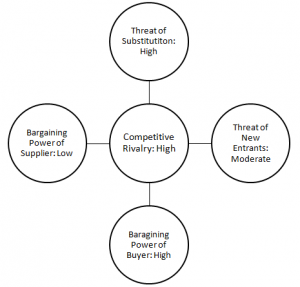China Machine Press Case Study Solution
Industry Analysis (Porter’s Five Forces Model)
Porter’s Five Forces Model could be used to analyze the attractiveness of the publishing industry China. A brief analysis of the Porter’s Five Forces is given as follows;
Threat of New Entrants
Threats of new entrants in the Chinese Publishing Industry is moderate. The potential growth in the industry tends to attract new entrants to the publishing industry. However, the presence of intense competition and the requirement of huge capital tends to demotivate new entrants to enter in the market.
Threat of Substitution
Threat of Substitution is high for the Chinese Publishing Industry. The substitute products for the published documents is the documents presented in the digital libraries on certain websites. The changing consumer preferences towards digital learning increase the threat of substitution for the industry.
Competitive Rivalry
Competitive rivalry in the publishing industry is high. The presence of large number of consumers in the Chinese Publishing Industry like CIP, PTP etc. tends to produce high competitive rivalry for CMP. Along with it, new entrants are also entering into the market increasing the competition for CMP.
Bargaining Power of Supplier
The major suppliers of the CMP include the suppliers of the paper for publishing documents. As CMP is the largest publisher in the Chinese Publishing Market, therefore the overall bargaining power of supplier for CMP is low.
Bargaining Power of Buyer
Bargaining power of buyer in the publishing industry is high. Due to the presence of a large number of publishers in the Chinese market and the market saturation, the buyers requires high quality documents at competitive prices.
Competitors Analysis
CMP operates in a highly competitive industry with the presence of large number of competitors. However, the company has a competitive position in the market with the highest market share in the Chinese publishing market. Major competitors of CMP include;
- Chemical Industry Press (CIP)
- Posts and telecommunication Press (PTP)
Chemical Industry Press (CIP)
CIPis one of the close competitors of CMP. Founded in the same period, CIP publishes similar type of books. For a large time period, CIP held the largest market share, and still ranks second and third in various market segments, with a major focus on educational publications. CIP acts as a threat for CMP as it could wean its market share due to its long term competitive background. CIP is focused on digital publishing and could wean the market share of CMP easily in the current market scenario.
Posts and telecommunication Press (PTP)
Another close competitor of CMP is PTP. It was also founded in the same period as CMP and CIP. It ranks 6th in the state-owned publishers in terms of business scale. It is also one of the prominent players in the publishing industry with an annual total revenues of RMB 550 million in 2010.
Alternatives
Alternative-1: Expand towards New Markets
Pros
- Reducing dependence over the Chinese markets.
- Increasing number of Customers
- Growth opportunities.
- Avoiding the impact of market saturation in the Chinese publishing industry.
Cons
- Use of potential resources in expansion.
- Risk of failure in new markets.
- Time consuming.
Alernative-2: Introduce Digital Publishing
Pros
- Sustaining consumer base.
- Approaching new markets.
- Easy to introduce using current capabilities.
- Low risk of Failure.
- Low requirement for funds.
- Increased product portfolio provides high value to customers.
Cons
- Competition in the market by CIP, who has prior focus on the digital publishing.
- Shift of focus from the core business segments to the new one can lead the company to lose demand of its products in the market.
Recommendations
With the deep analysis of the internal and external environment of the company along with the industry analysis and the competitor analysis, Alternative 2 is recommended to CMP to achieve its future development. As the preferences are shifting towards digital publishing and the company require an immediate solution to avoid the declining industry growth. Therefore, introduction of digital publishing could prove to be an immediate solution with low amount of risk for the company. However, the company could also consider the expansion program after the success of its digital publishing program.
Implementation
In order to introduce digital publishing in its product portfolio, the company should first gathers the data related to the consumer demand, the potential markets, the government regulations and the data related to the competitors presented in the market. After that, the company should decide one potential segment for its initial offering. It should collect research that how it could differentiate its digital publishing from the existing competitors’ products. After all the steps above the company should go for the initial offering. If the initial offering proves a success, the company should go for the other markets. In this way the company would be able to implement its digital publishing program.
Conclusion
Although, the growth of the publishing industry is declining since 2008, showing a threat to the company’s long term existence, but the situation can be controlled by considering a development plan in the future. The company could consider introducing digital publishing in its existing market to implement its development program at immediate basis and to avoid the risk of failure for entrance in the new markets.
Appendices
Appendix-1: SWOT Analysis
| Strengths | Weaknesses | Opportunities | Threats |
| · Long term experience
· Technical resources and capabilities · Vast product portfolio · Financial resources
|
· Traditional ways of publishing.
· Reliance over Chinese markets for Growth.
|
· Introduction of Digital Publishing
· Expansion towards foreign markets.
|
· Introduction of digital publishing i.e. digital libraries
|
Appendix-2: PESTEL Analysis
| Political | Economical | Social | Technological | Environmental | Legal |
| · Communist ideology of the Government.
· Supervision and Control of on the publishing sector. |
· Income Level of consumers.
· Paper prices. · Inflation Rate. · Imported Books. |
· Shifting Consumer Preferences.
· High Population Growth in China. |
· Introduction of Digital Publishing.
· Improvement of science and technology. |
· Concerns of Environmental Communities regarding the use of paper and ink. | · Publishing Ordinance 1997 |
Appendix-3: Porter’s Five Forces Model
This is just a sample partical work. Please place the order on the website to get your own originally done case solution.











